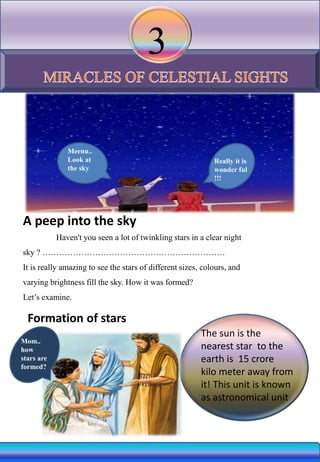
astronomy
- 1. A peep into the sky Haven't you seen a lot of twinkling stars in a clear night sky ? ………………………………………………………… It is really amazing to see the stars of different sizes, colours, and varying brightness fill the sky. How it was formed? Let’s examine. Formation of stars The sun is the nearest star to the earth is 15 crore kilo meter away from it! This unit is known as astronomical unit 3 Meenu.. Look at the sky Really it is wonder ful !!! Mom.. how stars are formed?
- 2. • Are all the stars seen in same colour? ………………………………………………… • what are the coloures you have observed? ………………………………………....... • Classify the stars on the basis of its colour RED BLUE ORANGE Thrikketa Regal Aldibaren Thiruvathira ……………. ……………….. ………………….. ……………… …………………. • Which are the group of stars that you have identified? ………………………………………………… Write in your science diary the name and form or shape of the constellation you have identified. Mom..are All stars same?
- 3. Gaseous clouds in the interstellar space itself is the birth place of stars .these gaseous clouds are known as nebula.. In which contain hydrogen, helium, and other molecules in a small amount. under the effect of gravitational force gaseous clouds in the nebula concentrated into the Centre. it is the first stage of birth of the stars. Due to the increasing of gravitational force all the gases and particles continuously moves and concentrated into the centre. Temperature for the fusion is produced due to the gravitational force. Which nebula will formed to stars easily. heavy mass nebula or light mass nebula? ……………………………………………………………………… Big dipper These are the some constellation
- 4. Solar systems • Haven’t you seen certain objects among the stars which do not twinkle ? ……………………………………………………………. • What are they? ……………………………………………………………… • Have you seen an object shining like a star in the west after sunset? ……………………………………………………………… The heavenly body can be seen in the morning at other times in the east. This is not a star. it is the planet Venus! international astronomical union – the planets are heavenly bodies that revolve around the sun in a fixed orbit . according to
- 5. solar system. • How many planets are there in a solar system? ………………………………………………………… • what are they? …………………………………………………........... • why did lose pluto’s position from the solar system? ………………………………………………………. venus, mars& earth are mainly composed of solid substances like rock, iron and nickel. They are called terrestrial planets. mercury, Saturn, Uranus& Neptune are mainly composed of gases such as hydrogen& methane .they are called jovian planets. jupiter
- 6. Besides planets and satellites there are other members too in the solar system Asteroids Between the orbits of mars & Jupiter a group of celestial objects are revolve around the sun, they are called asteroids, we can see them only with the help of telescope.. meteores During some night we can see certain objects in the sky burning down through the atmosphere. They are meteors. comets Comets travels the farthest.t hey revolve around the sun in an elliptical orbit. It consist of condensed gases and rock pieces.
- 7. Chandrayan project chandrayan I is India's first ever mission to explore the moon.it was launched from the Sathish Dhawan space centre in Sriharikotta on 22nd October 2008, by the PSLV C-11 it started revolving round the moon in a polar orbit of 100km height. On 14th November it created history by seperating the moon impact probe(MIP) from the mother vehicle and landing it near the south pole on the surface of the moon. Chandrayan I aims to study this neighbour of ours for the next two years by remote sensing with the help of ten scientific equipments. The basic aim of this project is enhance to our knowledge about the only natural satellite of earth, the moon. Besides it also proposes to increase India's technological expertise in the field of technology and to equip and enable the new generation Indian scientists to face fresh challenges in interplanetary researches. MIP PSLV 11
- 8. Significant learning outcomes The learner can • Explain the characteristics of different stars seen in the clear night sky • Explain the formation of stars. • Identify the stars by looking at its shape • explain the solar systems and the celestial bodies other than the nine planets. • Explain the expedition to moon by India and other countries. Let us assess 1) Describes the formation of stars ? 2) Draw and label the solar system and planets. 3) Now we have only 8 planet. Which planet lost its position as a planet? why? 4) What is asteroids? Where it is found? 5) What are the characteristics of meteroids? 6) Briefly explain about comets? 7) Write a short note on expedition to moon by India
- 9. Extended activity 1. Make a model for solar system 2. List out various type of celestial bodies which are not mentioned in the text book. 3. Find out more examples for stars which having different colours. 4. Explain the formation and the death of stars. 5. make short note on the missions promoted by India. 6. Make a chart of planets including the details of satellites in which have.